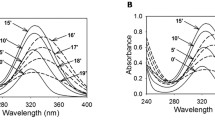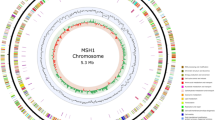Abstract
Strain Ochrobactrum lupine TP-D1 was found to degrade chlorothalonil (TPN) to 4-hydroxy-chlorothalonil (TPN-OH). To clone the related degrading gene, genomic library of TP-D1 was constructed using Escherichia coli DH10B and two positive clones 889 and 838 were gained. However, no plasmid was detected in clone 889. And in clone 838, a 3494 bp fragment was cloned which contains a 984 bp hydrolytic dehalogenase (chd) gene and a 1926 bp insertion element IS-Olup. The insertion element contains a transposase coding region (1026 bp), an ATP-binding protein coding region (657 bp) and flanked by 20 bp inverted repeat sequences. Further isolation provided another seven TPN-degrading strains, they belonged to the genera of Pseudomonas sp., Achromobacter sp., Ochrobactrum sp., Ralstonia sp., and Lysobacter sp. PCR strategy showed that they all contain the same structure of chd gene and the upstream IS-Olup. Our evidences collectively suggest that chd gene may be disseminated through horizontal gene transfer based on phylogenetic analysis of the cluster and their host bacterial strains. At the same time, the chd gene was amplified from genome of the positive clone 889, which also provides some potential evidence to the gene horizontal transfer.




Similar content being viewed by others
References
Ballee DL, Duane WC, Stallard DE et al (1976) Chlorothalonil analytical methods of pesticide and plant growth regulators. Academic Press, London
EPA (1999) Chlorothalonil Reregistration Eligibility Decision (R.E.D.). http://www.epa.gov/REDsS. Accessed January 2007
Hoffmann D, Kleinsteuber S, Muller RH et al (2003) A transposon encoding the complete 2,4-dichlorophenoxyacetic acid degradation pathway in the alkalitolerant strain Delftia acidovorans P4a. Microbiology 149:2545–2556
Katayama A, Ukai T, Nomura K et al (1992) Formation of a methylthiolated metabolite from the fungicide chlorothalonil by soil bacteria. Japan Society for Bioscience Biotechnology and Agrochemistry, Tokyo, JAPAN
Kim Y-M, Park K, Joo G-J et al (2004) Glutathione-dependent biotransformation of the fungicide chlorothalonil. J Agric Food Chem 52:4192–4196
Kwon J-W, Armbrust KL (2006) Degradation of chlorothalonil in irradiated water/sediment systems. J Agric Food Chem 54:3651–3657
Motonaga K, Takagi K, Matumoto S (1996) Biodegradation of chlorothalonil in soil after suppression of degradation. Biol Fertil Soils 23:340–345
Orme S, Kegley S (2006) PAN Pesticide Database, Pesticide Action Network, North America. http://www.pesticideinfo.org/Docs/ref_toxicity3.htmlS. Accessed January 2007
Regitano JB, Tornisielo VL, Lavorenti A et al (2001) Transformation pathways of 14C-chlorothalonil in tropical soils. Arch Environ Contam Toxicol 40:295–302
Rouchaud J, Roucourt P, Vanachter A et al (1988) Hydrolytic biodegradation of chlorothalonil in the soil and in cabbage crops. Toxicol Environ Chem 17:59–68
Sakkas VA, Lambropoulou DA, Albanis TA (2002) Study of chlorothalonil photodegradation in natural waters and in the presence of humic substances. Chemosphere 48:939–945
Sambrook J, Fritsch EF, Maniatis T (1989) Molecular cloning: a laboratory manual. Cold Spring Harbor Laboratory, New York
Sato K, Tanaka H (1987) Degradation and metabolism of a fungicide, 2,4,5,6-tetra-chloroisophthalonitrile (TPN) in soil. Biol Fertil Soils 3:205–209
Shi X, Li S, Guo R, Miao Z et al (2007) Detection of the biodegradation products of Chlorothalonil by Ochrobactrum lupini TP-D1. Journal of Beijing University of Chemical Technology 34
Siddavattam D, Khajamohiddin S, Manavathi B et al (2003) Transposon-like organization of the plasmid-borne organophosphate degradation (opd) gene cluster found in Flavobacterium sp. Appl Environ Microbiol 69:2533–2539
Tan HM (1999) Bacterial catabolic transposons. Appl Microbiol Biotechnol 51:1–12
Ukai T, Itou T et al (2003) Degradation of chlorothalonil in soils treated repeatedly with chlorothalonil. Pesticide Science Society of Japan, Tokyo, Japan
Wilkinson CF, Killeen JC (1996) A mechanistic interpretation of the oncogenicity of chlorothalonil in rodents and an assessment of human relevance. Regul Toxicol Pharmacol 24(1):69–84
Wyndham RC, Cashore AE, Nakatsu CH et al (1994) Catabolic transposons. Biodegradation 5:323–342
Yanagi M, Yamasato K (1993) Phylogenetic analysis of the family Rhizobiaceae and related bacteria by sequencing of 16S rRNA gene using PCR and DNA sequencer. FEMS Microbiol Lett 107(1):115–120
Zhang R, Cui Z, Zhang X et al (2006) Cloning of the organophosphorus pesticide hydrolase gene clusters of seven degradative bacteria isolated from a methyl parathion contaminated site and evidence of their horizontal gene transfer. Biodegradation 17:465–472
Acknowledgments
This work is supported by the National High Technology Research of “863” Program of China (Grant No. 2008AA10Z403).
Author information
Authors and Affiliations
Corresponding author
Rights and permissions
About this article
Cite this article
Ren, X., Li, H. & Chen, S. Cloning of the Chlorothalonil-Degrading Gene Cluster and Evidence of Its Horizontal Transfer. Curr Microbiol 62, 1068–1073 (2011). https://doi.org/10.1007/s00284-010-9824-x
Received:
Accepted:
Published:
Issue Date:
DOI: https://doi.org/10.1007/s00284-010-9824-x




